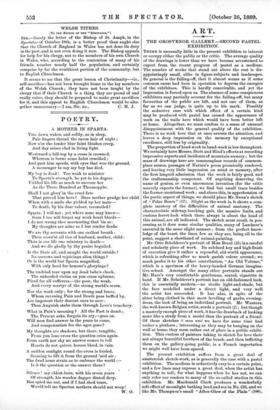ART.
THE GROSVENOR GALLERY.—SECOND PASTEL. EXHIBITION.
THERE is unusually little in the present exhibition to interest or occupy either the public or the critic. The average quality of the drawings is lower than we have become accustomed to. expect from the recent progress of pastel as a medium.. The number of works that stand out above the rest is dis- appointingly small, alike in figure-subjects and landscapes. So general is the falling-off, that it almost seems as if some
common cause had been in operation to depress the energies of the exhibitors. This is hardly conceivable, and yet the impression is forced upon us. The absence of some conspicuous exhibitors may partially account for the falling-off, but many favourites of the public are left, and not one of them, as far as we can judge, is quite up to his mark. Possibly the seductive ease with which effect of a certain kind may be produced with pastel has caused the appearance of work on the walls here which would have been better left at home. Altogether, we must confess to a sense of unusual disappointment with the general quality of the exhibition_ There is no work here that at once arrests the attention, and leaves a deep impression on the memory by exceptional excellence, still less by originality.
The proportion of head-work to hand-work is low throughout.
We certainly have Messrs. Stott and Hind's efforts at recording impressive aspects and incidents of mountain scenery ; but the mass of drawings here are commonplace records of common- place scenes, passages of Nature's prose prosaically rendered, and leaving very little impression on mind or memory, after the first languid admission that the work is fairly good, and the craftsmanship competent. Of anything deserving the name of genius, or even uncommon invention (for the critic scarcely expects the former), we find but small trace besides the former-mentioned work ; and above this, in apprehension of the poetic aspect of things, we should place Mr. Swan's sketch of " Polar Bears" (57). Slight as the work is, it shows a com- plete mastery of the difficulties of animal anatomy. The characteristic sideway-lurching gait, the massive limbs, and curious ferret-look which there always is about the head of this animal, are all indicated. The sketch must recall, in pos- sessing as it does some similar qualities, many of Landseer's executed in the same slight manner ; from the perfect know- ledge of the beast, the lines, few as they are, being all to the point, suggest a shorthand of animal-painting.
Mr. Otto Scholderer's portrait of Miss Breul (25) is a careful
and scholarly piece of work. Its subdued key and high finish of execution give it rather a reposeful, old-world appearance, which is refreshing after so much garish colour around; we much prefer it to his other contribution, "An Old Volume," which is a specimen of the heavy-handed German imagina- tive school. Amongst the many other portraits stands out Mr. Hare's very comfortable gentleman, seated, cigarette in hand. If Mr. Scholderer's portrait has an old-fashioned look, this is essentially modern,—n.o studio light-and-shade, but the face modelled under a direct light, and very well the artist has succeeded. It has also, in spite of the sitter being clothed in that most levelling of garbs, evening- dress, the look of being an individual portrait. Mr. Wauters, the well-known Belgian artist, sends a portrait (2) ; but though a masterly enough piece of work, it has the drawback of looking more like a study from a model than the portrait of a friend. Of these sketches a mom anti we have for some time bad rather a plethora ; interesting as they may be hanging on the wall at home, they seem rather out of place in a public exhibi- tion. This custom of painters taking to sketch for love their- not always beautiful brothers of the brush, and then inflicting them on the gallery-going public, is a French importation. we might well have been spared.
The present exhibition suffers from a great deal of amateurish sketch-work, as is generally the case with a pastel exhibition. The medium is seductively easy to a certain point„ and a few lines may express a great deal, when the artist has anything to tell ; for what happens when be has not, we can only refer our readers to many of the so-called studies in this exhibition. Mr. Macdonald Clark produces a wonderfully soft effect of moonlight bathing land and sea in No. 226, and we like Mr. Thompson's small "After-Glow of the Plain" (109). Mr. Graham Petrie's " By the River " (70) is a harmonious study of tender greens and greys; and Mr. Ponsonby-Staples seems equally at home whether in treating the humours of the poultry-yard or the movement of graceful figures in har- monious landscape. Mr. Van Chelminski contributes the only touch of the military, in his " Despatches to the Front " (362), a dashing aide-de-camp of 1815 who, heavily cocked- hatted and severely stocked, rattles his crop-tailed grey across the heavy ploughed land. Flimsy prettiness is the most pro- minent attribute of the work of the clever Italian, Signor Tofano, who does not succeed in his studies of English girlish grace and beauty as well as artists of his school and nationality seem to do with Parisian combinations of brie-a- brue and demi-monde. Mr. Solomon's curious study in daring foreshortening, which he calls "An Amazon" (83), shows all his accustomed skill in modelling and appreciation of values.







































 Previous page
Previous page